University Microeconomics Assignment: Detailed Analysis and Solutions
VerifiedAdded on 2019/10/31
|8
|961
|120
Homework Assignment
AI Summary
This document presents a comprehensive solution to a microeconomics assignment, addressing key concepts such as consumer behavior, demand curves, and cost analysis. The solution delves into topics including the identification of preferred bundles of goods and services, the analysis of perfect substitutes, and the graphical representation of indifference curves. It also explores short-run and long-run cost curves, illustrating the relationship between average and marginal costs. Furthermore, the assignment investigates marginal utility and the marginal rate of substitution, providing a thorough understanding of economic principles. The document includes figures to visually represent key concepts and references relevant economic literature.
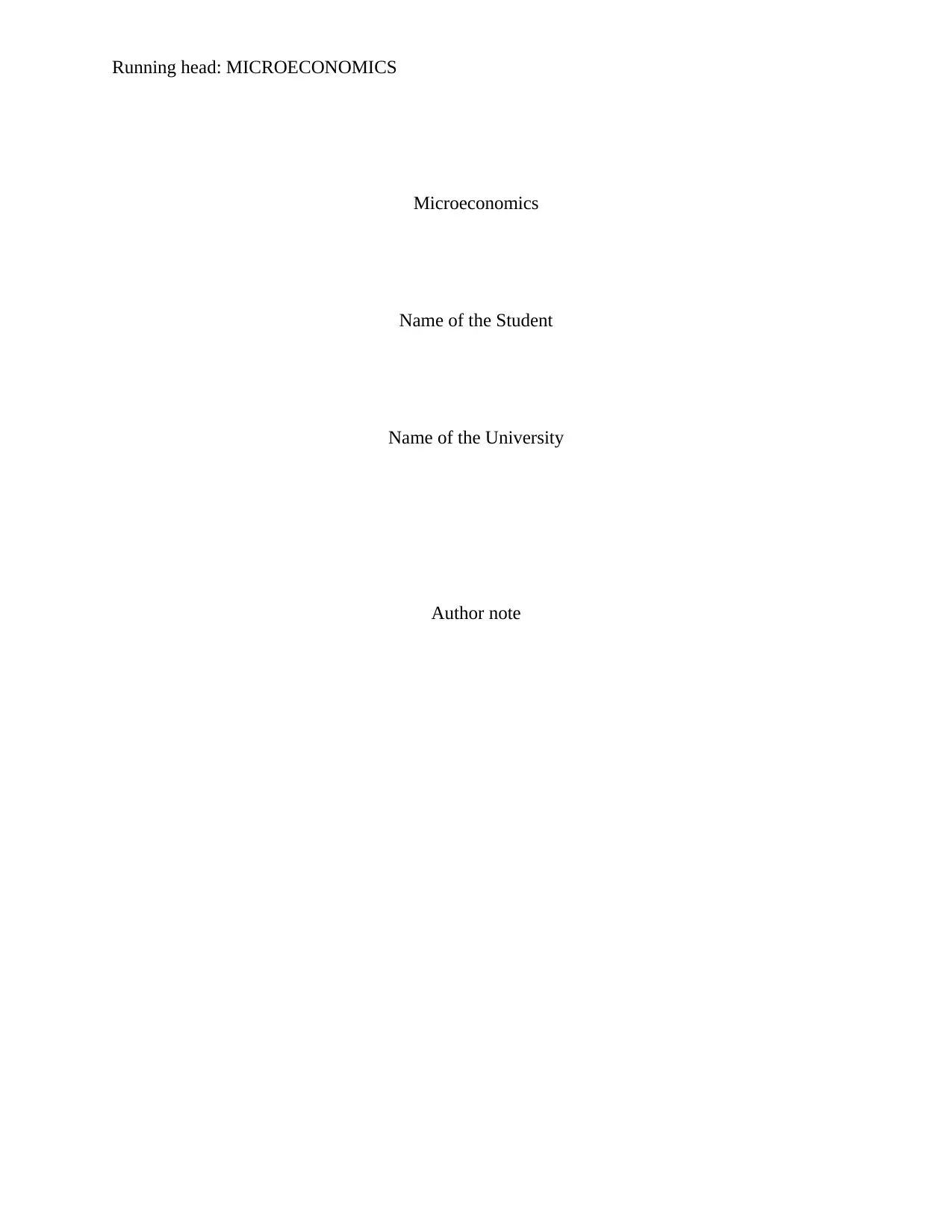
Running head: MICROECONOMICS
Microeconomics
Name of the Student
Name of the University
Author note
Microeconomics
Name of the Student
Name of the University
Author note
Paraphrase This Document
Need a fresh take? Get an instant paraphrase of this document with our AI Paraphraser
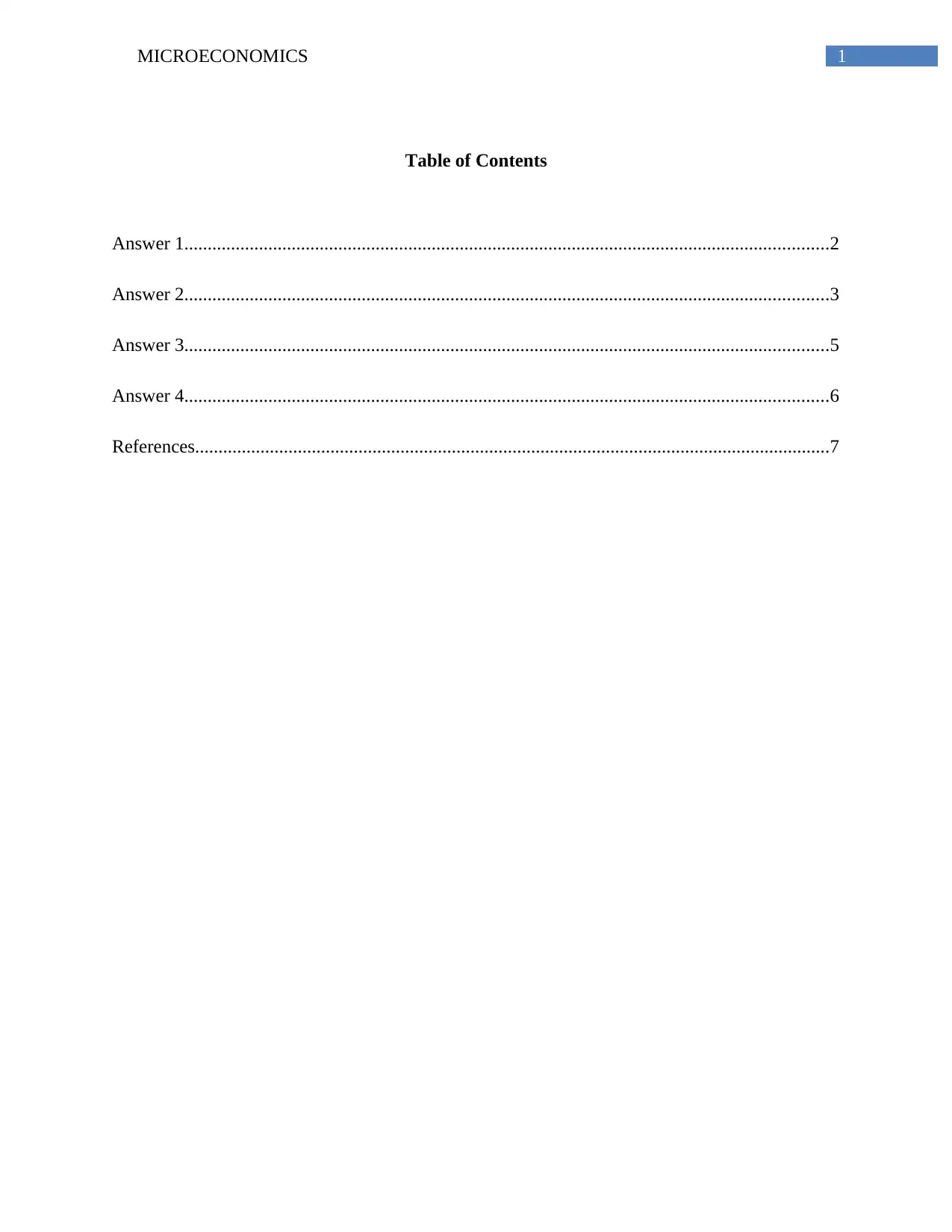
1MICROECONOMICS
Table of Contents
Answer 1..........................................................................................................................................2
Answer 2..........................................................................................................................................3
Answer 3..........................................................................................................................................5
Answer 4..........................................................................................................................................6
References........................................................................................................................................7
Table of Contents
Answer 1..........................................................................................................................................2
Answer 2..........................................................................................................................................3
Answer 3..........................................................................................................................................5
Answer 4..........................................................................................................................................6
References........................................................................................................................................7
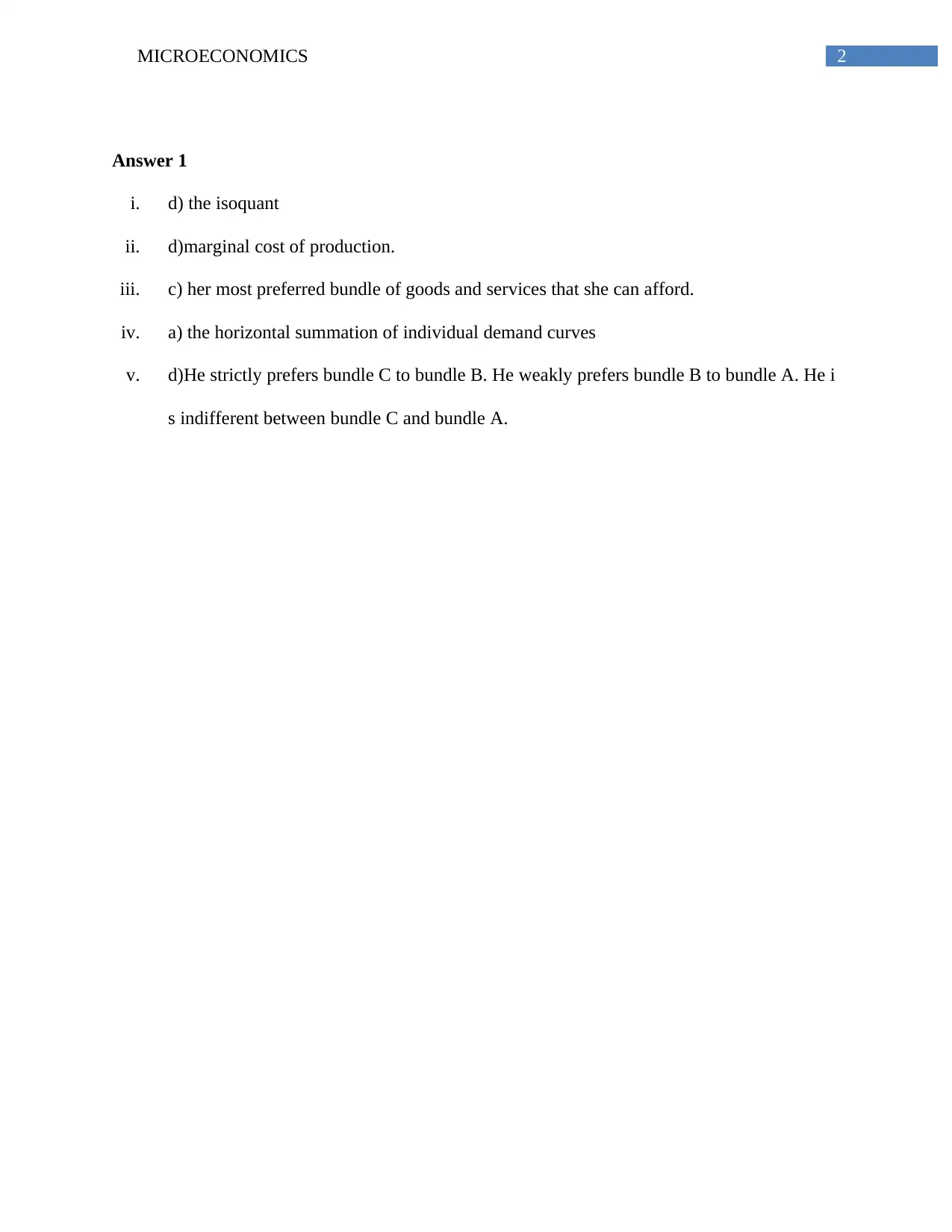
2MICROECONOMICS
Answer 1
i. d) the isoquant
ii. d)marginal cost of production.
iii. c) her most preferred bundle of goods and services that she can afford.
iv. a) the horizontal summation of individual demand curves
v. d)He strictly prefers bundle C to bundle B. He weakly prefers bundle B to bundle A. He i
s indifferent between bundle C and bundle A.
Answer 1
i. d) the isoquant
ii. d)marginal cost of production.
iii. c) her most preferred bundle of goods and services that she can afford.
iv. a) the horizontal summation of individual demand curves
v. d)He strictly prefers bundle C to bundle B. He weakly prefers bundle B to bundle A. He i
s indifferent between bundle C and bundle A.
⊘ This is a preview!⊘
Do you want full access?
Subscribe today to unlock all pages.

Trusted by 1+ million students worldwide
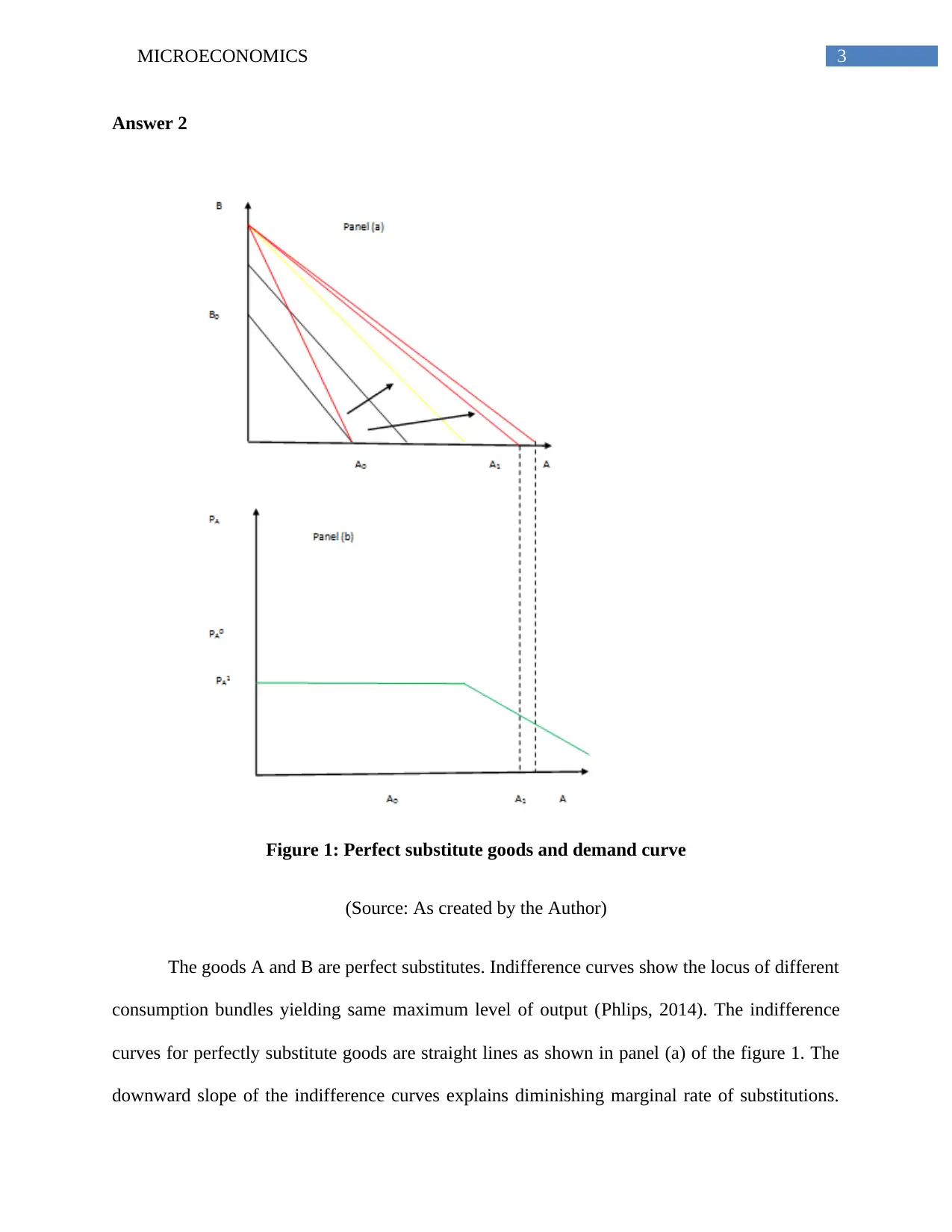
3MICROECONOMICS
Answer 2
Figure 1: Perfect substitute goods and demand curve
(Source: As created by the Author)
The goods A and B are perfect substitutes. Indifference curves show the locus of different
consumption bundles yielding same maximum level of output (Phlips, 2014). The indifference
curves for perfectly substitute goods are straight lines as shown in panel (a) of the figure 1. The
downward slope of the indifference curves explains diminishing marginal rate of substitutions.
Answer 2
Figure 1: Perfect substitute goods and demand curve
(Source: As created by the Author)
The goods A and B are perfect substitutes. Indifference curves show the locus of different
consumption bundles yielding same maximum level of output (Phlips, 2014). The indifference
curves for perfectly substitute goods are straight lines as shown in panel (a) of the figure 1. The
downward slope of the indifference curves explains diminishing marginal rate of substitutions.
Paraphrase This Document
Need a fresh take? Get an instant paraphrase of this document with our AI Paraphraser
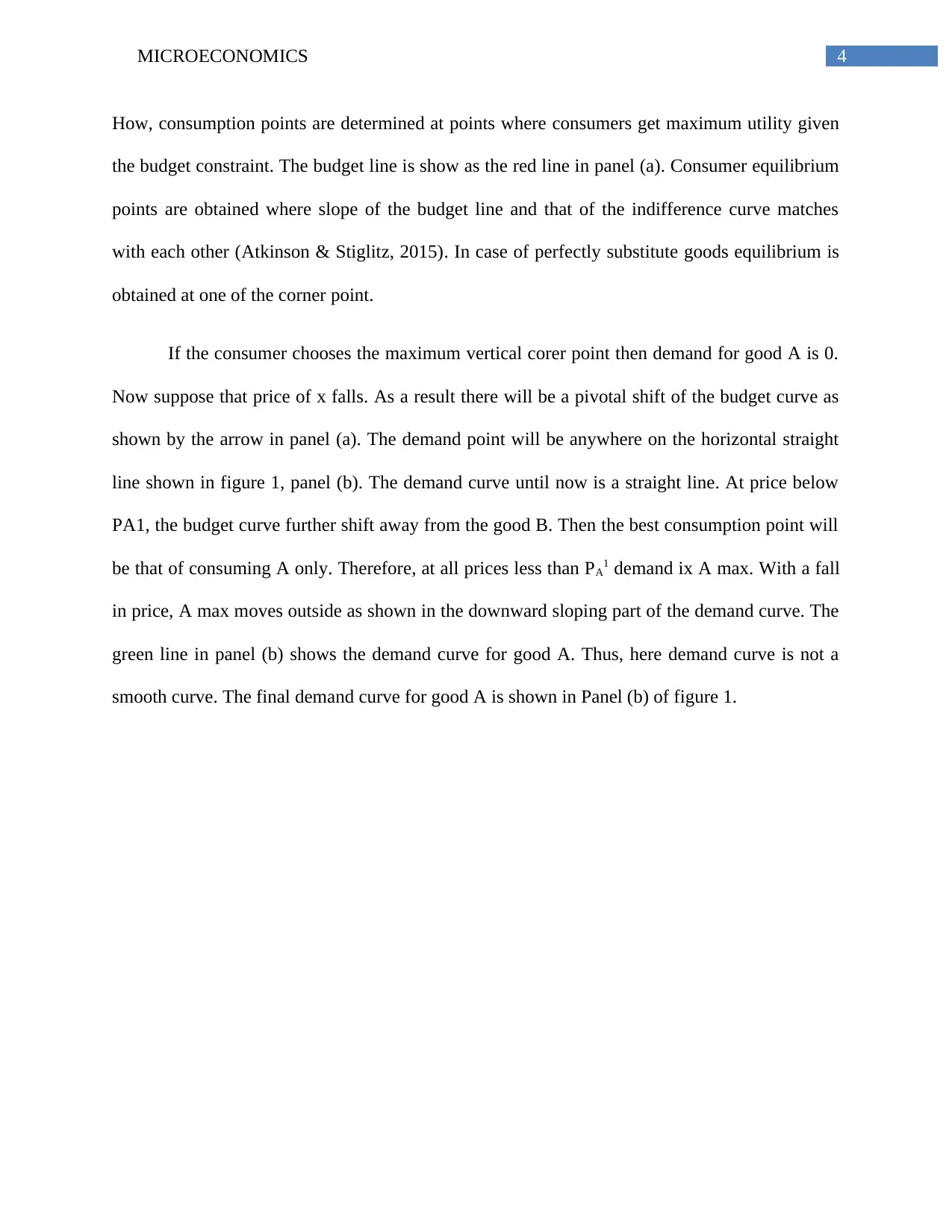
4MICROECONOMICS
How, consumption points are determined at points where consumers get maximum utility given
the budget constraint. The budget line is show as the red line in panel (a). Consumer equilibrium
points are obtained where slope of the budget line and that of the indifference curve matches
with each other (Atkinson & Stiglitz, 2015). In case of perfectly substitute goods equilibrium is
obtained at one of the corner point.
If the consumer chooses the maximum vertical corer point then demand for good A is 0.
Now suppose that price of x falls. As a result there will be a pivotal shift of the budget curve as
shown by the arrow in panel (a). The demand point will be anywhere on the horizontal straight
line shown in figure 1, panel (b). The demand curve until now is a straight line. At price below
PA1, the budget curve further shift away from the good B. Then the best consumption point will
be that of consuming A only. Therefore, at all prices less than PA1 demand ix A max. With a fall
in price, A max moves outside as shown in the downward sloping part of the demand curve. The
green line in panel (b) shows the demand curve for good A. Thus, here demand curve is not a
smooth curve. The final demand curve for good A is shown in Panel (b) of figure 1.
How, consumption points are determined at points where consumers get maximum utility given
the budget constraint. The budget line is show as the red line in panel (a). Consumer equilibrium
points are obtained where slope of the budget line and that of the indifference curve matches
with each other (Atkinson & Stiglitz, 2015). In case of perfectly substitute goods equilibrium is
obtained at one of the corner point.
If the consumer chooses the maximum vertical corer point then demand for good A is 0.
Now suppose that price of x falls. As a result there will be a pivotal shift of the budget curve as
shown by the arrow in panel (a). The demand point will be anywhere on the horizontal straight
line shown in figure 1, panel (b). The demand curve until now is a straight line. At price below
PA1, the budget curve further shift away from the good B. Then the best consumption point will
be that of consuming A only. Therefore, at all prices less than PA1 demand ix A max. With a fall
in price, A max moves outside as shown in the downward sloping part of the demand curve. The
green line in panel (b) shows the demand curve for good A. Thus, here demand curve is not a
smooth curve. The final demand curve for good A is shown in Panel (b) of figure 1.
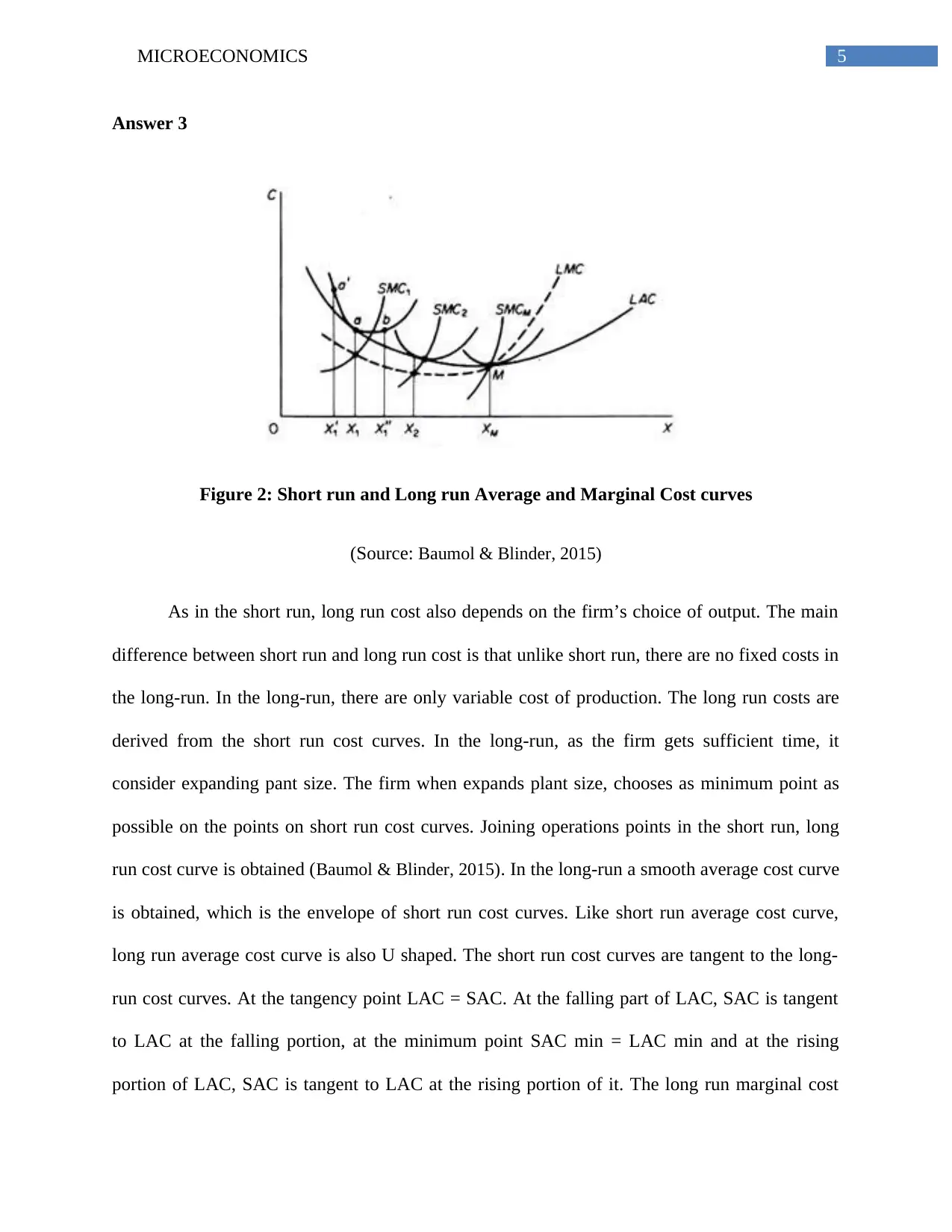
5MICROECONOMICS
Answer 3
Figure 2: Short run and Long run Average and Marginal Cost curves
(Source: Baumol & Blinder, 2015)
As in the short run, long run cost also depends on the firm’s choice of output. The main
difference between short run and long run cost is that unlike short run, there are no fixed costs in
the long-run. In the long-run, there are only variable cost of production. The long run costs are
derived from the short run cost curves. In the long-run, as the firm gets sufficient time, it
consider expanding pant size. The firm when expands plant size, chooses as minimum point as
possible on the points on short run cost curves. Joining operations points in the short run, long
run cost curve is obtained (Baumol & Blinder, 2015). In the long-run a smooth average cost curve
is obtained, which is the envelope of short run cost curves. Like short run average cost curve,
long run average cost curve is also U shaped. The short run cost curves are tangent to the long-
run cost curves. At the tangency point LAC = SAC. At the falling part of LAC, SAC is tangent
to LAC at the falling portion, at the minimum point SAC min = LAC min and at the rising
portion of LAC, SAC is tangent to LAC at the rising portion of it. The long run marginal cost
Answer 3
Figure 2: Short run and Long run Average and Marginal Cost curves
(Source: Baumol & Blinder, 2015)
As in the short run, long run cost also depends on the firm’s choice of output. The main
difference between short run and long run cost is that unlike short run, there are no fixed costs in
the long-run. In the long-run, there are only variable cost of production. The long run costs are
derived from the short run cost curves. In the long-run, as the firm gets sufficient time, it
consider expanding pant size. The firm when expands plant size, chooses as minimum point as
possible on the points on short run cost curves. Joining operations points in the short run, long
run cost curve is obtained (Baumol & Blinder, 2015). In the long-run a smooth average cost curve
is obtained, which is the envelope of short run cost curves. Like short run average cost curve,
long run average cost curve is also U shaped. The short run cost curves are tangent to the long-
run cost curves. At the tangency point LAC = SAC. At the falling part of LAC, SAC is tangent
to LAC at the falling portion, at the minimum point SAC min = LAC min and at the rising
portion of LAC, SAC is tangent to LAC at the rising portion of it. The long run marginal cost
⊘ This is a preview!⊘
Do you want full access?
Subscribe today to unlock all pages.

Trusted by 1+ million students worldwide
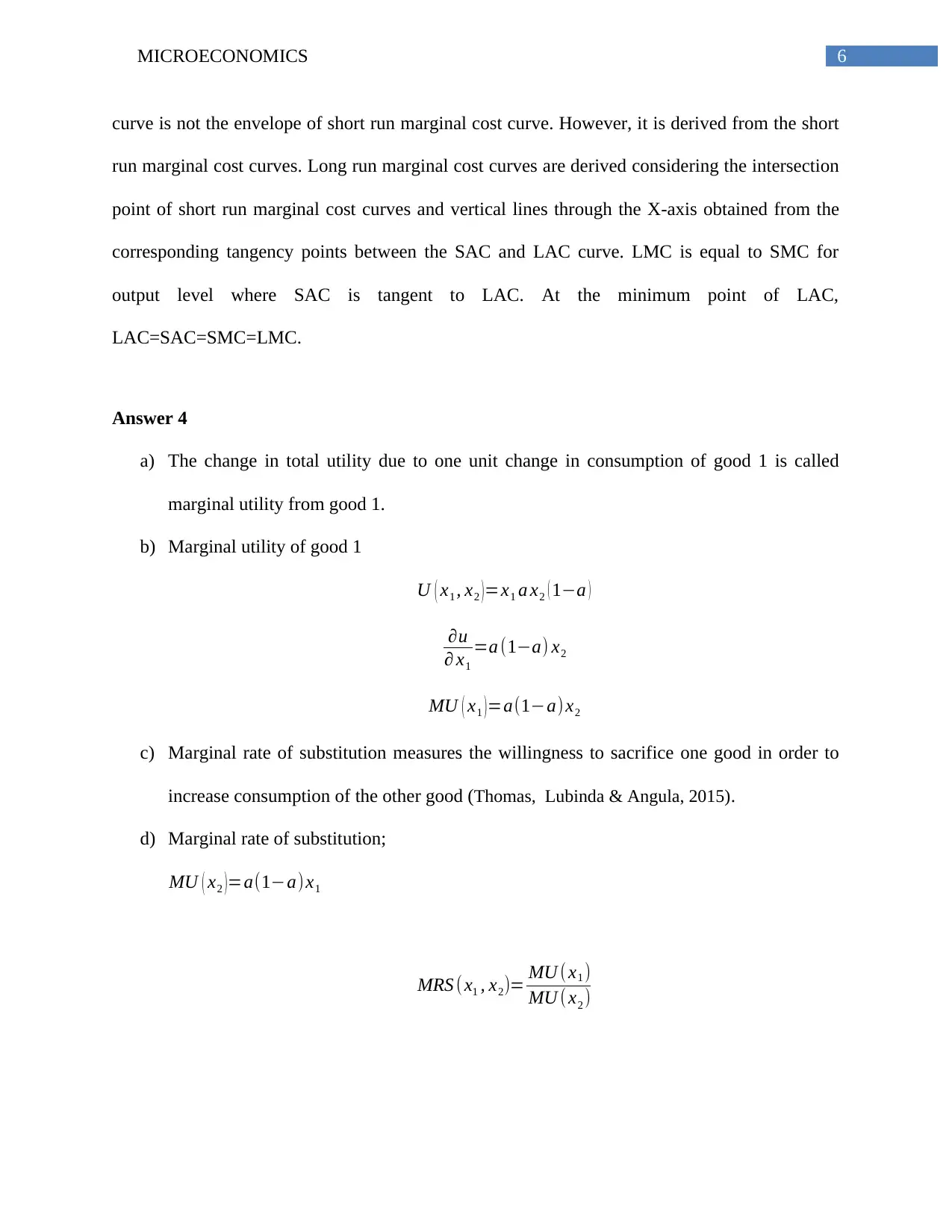
6MICROECONOMICS
curve is not the envelope of short run marginal cost curve. However, it is derived from the short
run marginal cost curves. Long run marginal cost curves are derived considering the intersection
point of short run marginal cost curves and vertical lines through the X-axis obtained from the
corresponding tangency points between the SAC and LAC curve. LMC is equal to SMC for
output level where SAC is tangent to LAC. At the minimum point of LAC,
LAC=SAC=SMC=LMC.
Answer 4
a) The change in total utility due to one unit change in consumption of good 1 is called
marginal utility from good 1.
b) Marginal utility of good 1
U ( x1 , x2 ) =x1 a x2 ( 1−a )
∂u
∂ x1
=a (1−a) x2
MU ( x1 )=a(1−a)x2
c) Marginal rate of substitution measures the willingness to sacrifice one good in order to
increase consumption of the other good (Thomas, Lubinda & Angula, 2015).
d) Marginal rate of substitution;
MU ( x2 )=a(1−a)x1
MRS ( x1 , x2)= MU ( x1 )
MU ( x2 )
curve is not the envelope of short run marginal cost curve. However, it is derived from the short
run marginal cost curves. Long run marginal cost curves are derived considering the intersection
point of short run marginal cost curves and vertical lines through the X-axis obtained from the
corresponding tangency points between the SAC and LAC curve. LMC is equal to SMC for
output level where SAC is tangent to LAC. At the minimum point of LAC,
LAC=SAC=SMC=LMC.
Answer 4
a) The change in total utility due to one unit change in consumption of good 1 is called
marginal utility from good 1.
b) Marginal utility of good 1
U ( x1 , x2 ) =x1 a x2 ( 1−a )
∂u
∂ x1
=a (1−a) x2
MU ( x1 )=a(1−a)x2
c) Marginal rate of substitution measures the willingness to sacrifice one good in order to
increase consumption of the other good (Thomas, Lubinda & Angula, 2015).
d) Marginal rate of substitution;
MU ( x2 )=a(1−a)x1
MRS ( x1 , x2)= MU ( x1 )
MU ( x2 )
Paraphrase This Document
Need a fresh take? Get an instant paraphrase of this document with our AI Paraphraser
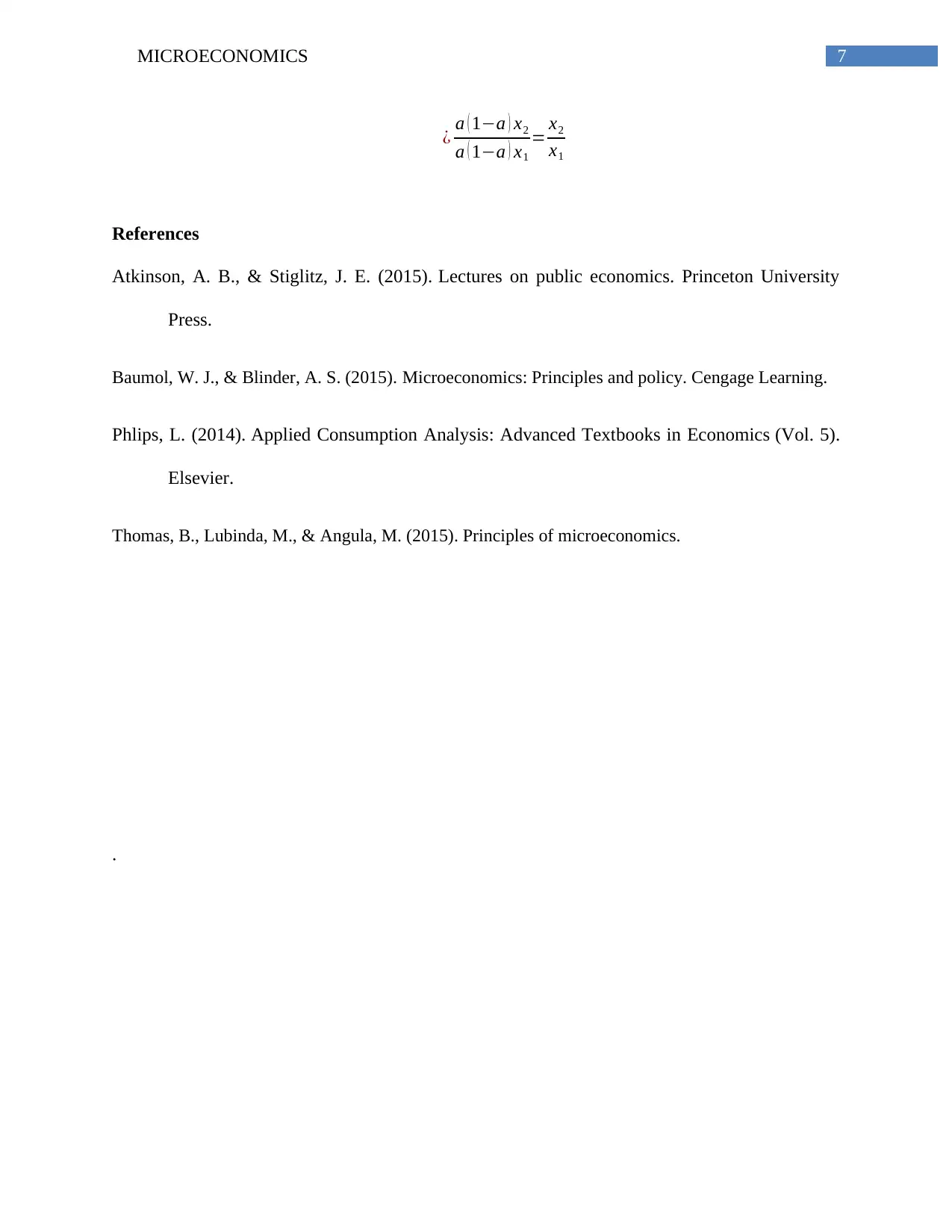
7MICROECONOMICS
¿ a ( 1−a ) x2
a ( 1−a ) x1
= x2
x1
References
Atkinson, A. B., & Stiglitz, J. E. (2015). Lectures on public economics. Princeton University
Press.
Baumol, W. J., & Blinder, A. S. (2015). Microeconomics: Principles and policy. Cengage Learning.
Phlips, L. (2014). Applied Consumption Analysis: Advanced Textbooks in Economics (Vol. 5).
Elsevier.
Thomas, B., Lubinda, M., & Angula, M. (2015). Principles of microeconomics.
.
¿ a ( 1−a ) x2
a ( 1−a ) x1
= x2
x1
References
Atkinson, A. B., & Stiglitz, J. E. (2015). Lectures on public economics. Princeton University
Press.
Baumol, W. J., & Blinder, A. S. (2015). Microeconomics: Principles and policy. Cengage Learning.
Phlips, L. (2014). Applied Consumption Analysis: Advanced Textbooks in Economics (Vol. 5).
Elsevier.
Thomas, B., Lubinda, M., & Angula, M. (2015). Principles of microeconomics.
.
1 out of 8
Related Documents
Your All-in-One AI-Powered Toolkit for Academic Success.
+13062052269
info@desklib.com
Available 24*7 on WhatsApp / Email
![[object Object]](/_next/static/media/star-bottom.7253800d.svg)
Unlock your academic potential
Copyright © 2020–2025 A2Z Services. All Rights Reserved. Developed and managed by ZUCOL.





